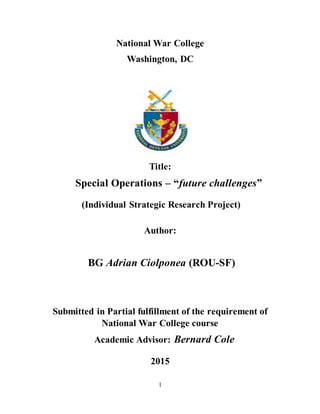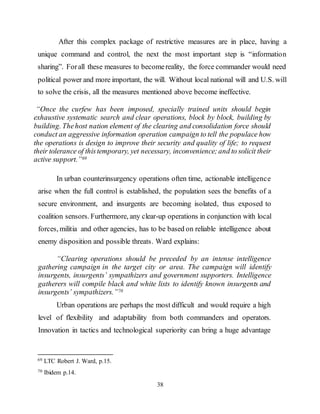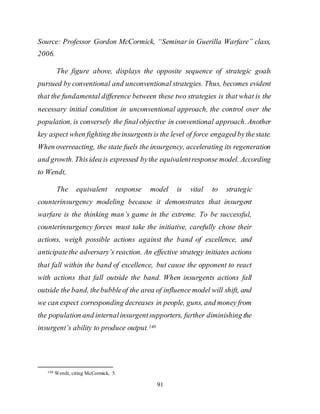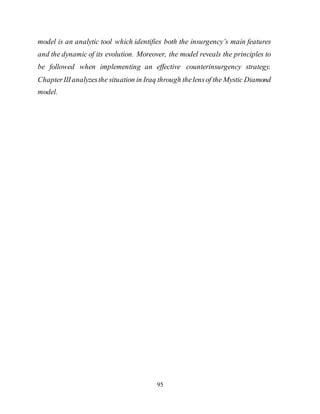This document provides an overview of future challenges for special operations, particularly in urban environments. It discusses the increasing likelihood of future warfare occurring in cities due to population growth and urbanization. Special operations forces are well-suited for urban warfare due to their flattened command structure and ability to operate independently. Effective communication is also key. The strategy for urban special operations should be part of a modern counterinsurgency approach that leverages interagency cooperation while overcoming bureaucratic barriers. Technological innovation can help integrate new urban tactics and minimize civilian casualties. Overall, an integrated "smart approach" utilizing all elements of national power is needed to effectively address hybrid threats in urban areas.












































































![77
the popular opinion about coalition forces shifts conversely they are perceived
less as “liberators” and more as “occupation forces.”
Because it is much easier to identify the movement sympathizers
than its participants, the unfortunate tendency is to apply repression
indiscriminately…This not only creates moral outrage, it destroys the
incentive not to join the battle among the opponent’s weakly committed
adherents.128
5. Inputs, Outputs, and the Conversion Mechanism
External support facilitates the growth of insurgency by providing
tactical, procedures, logistical support and communications. The core of the
problem is mainly not the multiplier role assured by external support, but the
indigenous support, which fuels the regeneration process.
External and internal support, flow to a cadre or infrastructure,
where they will be refined and translated into output. It is important to
note that supportwill likely come from a mixture of external and internal
sources. Defining where the majority of insurgentsupportis coming from
allows for the proportionate and correct application of COIN
[counterinsurgency] resources.129
A mechanism model is very important for an insurgency movement,
because it translates of inputs to outputs. Derived from the writings of Nanthan
Leites and Charles Wolf Jr, this model is vital for understanding thedifferences
between conventional and unconventional approaches to COIN, as well as for
128 Gordon H. McCormick, Frank Giordano, 308.
129 Erik P. Wendt,citing a lecture by McCormick, in Wendt,“Strategic Counterinsurgency Model,” (Fort
Bragg: Special Warfare Bulletin, September 2005), 5.](https://image.slidesharecdn.com/05683382-a4cc-4816-9ef1-540b2f4db666-150611013017-lva1-app6892/85/Special-Forces-future-challenges-77-320.jpg)



















![97
limited, U.S. forces made these non-lethal capabilities knownto the Somali population in advance,
deterring hostile crowds who initially were bent on “driving the Americans back into the sea.
”Since then, this program has sought to facilitate development and fielding of non-lethal weapons
to meet U.S. forces’ requirements. And, by 2011, needs had grown to the point that then-Assistant
Commandant of the Marine Corps Gen. Joseph Dunford stated, “The demand for non-lethal
weapons exceeds the inventory,” as reported by the Marine Corps Times. What Is Non-lethality
in DoD? “Non-lethal” means something that produces more nuanced effects to achieve a given
purpose. For countering personnel, examples of non-lethal effects include electro muscular
incapacitation that disables, glaring light that obscures vision, and millimeter wave energy that
heats nerve endings, repelling individuals. The term “non-lethal” is subject to varying
interpretations—and, while examples help elicit the scope of effects included in the non-lethal
spectrum, the topic is defined more clearly by DoD policy. DoD Directive 3000.03E, DoD
Executive Agent for Non-Lethal Weapons and Non-Lethal Weapons Policy, defines non-lethal
weapons as: Weapons, devices, and munitions that are explicitly designed and primarily employed
to incapacitate targeted personnel or materiel immediately, while minimizing fatalities, permanent
injury to personnel, and undesired damage to property in the target area or environment. NLW
[non-lethal weapons] are intended to have reversible effects on personnel and materiel. The
directive also states it is DoD policy that: Developers of NLW will conduct a thorough human
effects characterization in accordance with DoD Instruction (DoDI) 3200.19 to help understand
the full range of effects and limitations prior to operational employment of the NLW. In effect,
development and acquisition must include a process, unique to non-lethal weapons, which
accounts for the effects of the system on human targets. It is important to note that while human
effects on the target must be characterized for non-lethal weapons, they are not required to have
a zero probability of producing adverse effects. Instead, the human effects on the target are an
inherent attribute that will influence heavily the design of any non-lethal weapons system:
Achieving the desired effectiveness with an acceptable injury risk often is the crux of their
development. From the onset, programs should incorporate human effects into their overall risk
management approach similar to other aspects of the development. In fact, DoDI 3200.19, Non-
Lethal Weapons Human Effects Characterization, published in 2012, requires the human effects
of a required non-lethal capability be designated as a Key Performance Parameter (KPP) or Key
System Attribute (KSA).Characterizing Human Effects in Non-Lethal Weapons Acquisition](https://image.slidesharecdn.com/05683382-a4cc-4816-9ef1-540b2f4db666-150611013017-lva1-app6892/85/Special-Forces-future-challenges-97-320.jpg)



